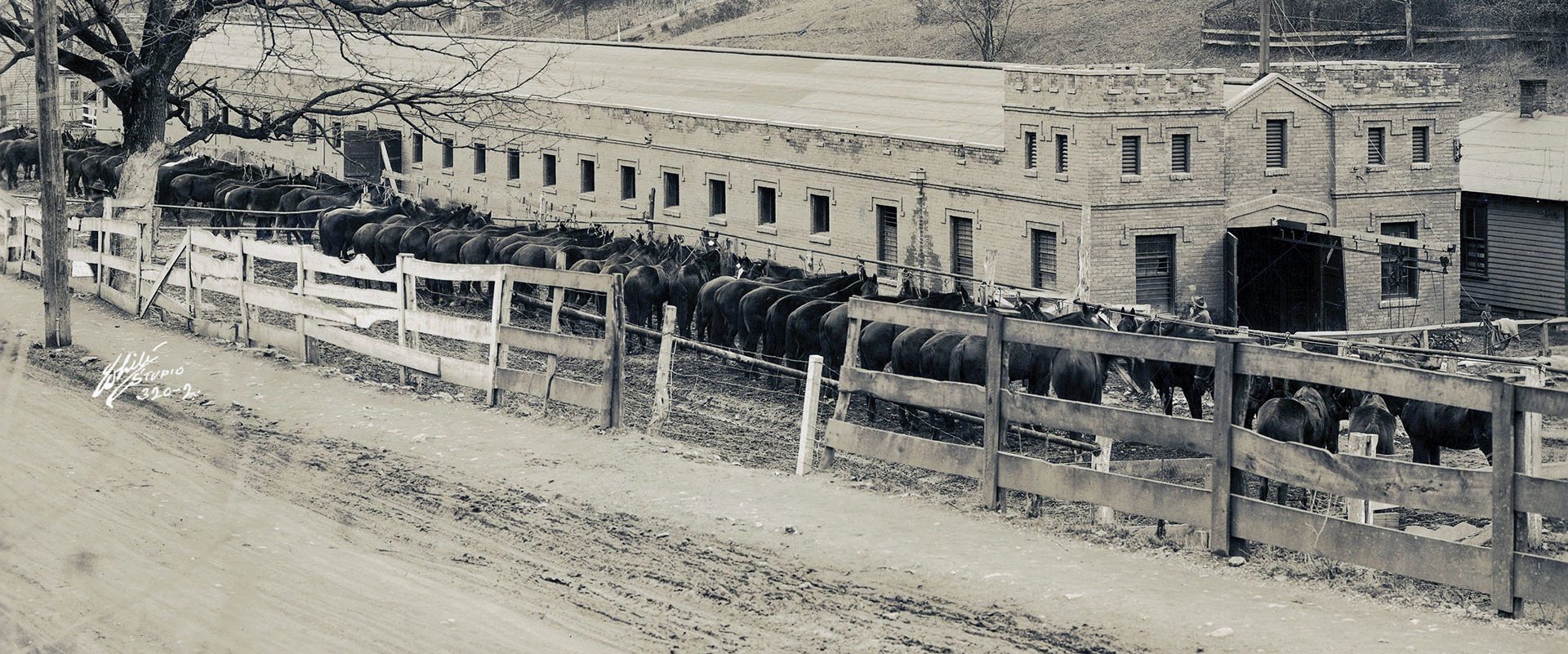A Day for VMI

Donations from alumni were used to build these stables, shown here in the 1920s.

Donations from alumni were used to build these stables, shown here in the 1920s.
On May 1, 2018, hundreds of alumni and friends participated in VMI’s Day of Giving. With the theme of Moe Needs a Ride, it urged the VMI family to make a gift to the Institute to help Moe. This event garnered more than $270,859 in immediate support – more than enough to get Moe back to barracks by taps.
While this was the first time that VMI joined other colleges and organizations in conducting a day of giving, it was not the first time that alumni have been urged to set aside one day to give to the Institute. The first “day of giving” actually occurred 101 years to the day before the recent event. And, like the event this May, it was aimed at reinforcing VMI’s proud citizen-soldier tradition.
Before World War I, it had become apparent to many leading Americans – including the presidents of numerous colleges and among them VMI’s superintendent, Brig. Gen. Edward G. Nichols – that if the United States entered a major conflict, the country would not have enough trained officers. In 1913, the U.S. Army established Student Military Camps – which were supported strongly by Maj. Gen. Leonard Wood, Army chief of staff – to help alleviate the situation. In 1915, the Plattsburgh Camps succeeded them. Congress took matters in hand the following year, passing the National Defense Act of 1916 which, among several provisions, established the Reserve Officer Training Corps – a uniform, nationwide program of officer training.
At the time, the cavalry remained an important arm of the Army, and almost all field artillery was horse-drawn. Thus, what was known as “mounted instruction” was an essential part of ROTC training. Under the terms of the new law, however, while the Army would provide horses, forage, equipment and a training cadre, VMI was required to build the stables and training grounds for the horses.
As it has since its earliest days, in order to raise the necessary funds – $10,000 – the Institute turned to its alumni. In January 1917, Nichols contacted William Couper ’904, who was a successful railroad executive in New York City and had established the New York Alumni Club in 1907, and asked him to organize the effort.
Couper agreed and, with seven other alumni in support, set to work with a purpose. The most daunting task was the creation of mailing lists. Starting with an admittedly incomplete list of 1,318 alumni compiled in 1915, they asked alumni chapters and individual alumni for names and addresses. In the space of three painstaking months, the committee created a card index containing more than 4,000 names and addresses.
The next question was what shape the mailing would take. It was decided to create a one-page circular that would present the necessary information and appeal for the recipient’s participation. An envelope stamped with the class of the recipient but otherwise blank and a stamped envelope addressed to Nichols, the chairman of the effort, would accompany it. The idea was the gift in the form of, as the circular stated, “draft, check, money order or coin of the realm” would go into the numbered envelope that, along with others, would be placed in a ballot box, thus allowing donors to remain anonymous. Those who wanted an acknowledgment of their gift were asked to enclose a stamped, self-addressed envelope in which Nichols would enclose a note of thanks.
Just as the 2018 Day of Giving had a hook, specifically Moe Needs a Ride, so too did the effort in 1918: A Day for VMI. This idea came from C.F. Dykeman ’906, a member of the committee. As the circular stated, “Every man who has worn the Grey can afford to give ONE DAY’S EARNINGS TO V.M.I.” The day chosen was the same in 1917 and 2018: May 1.
While the Day of Giving differed from A Day for VMI in that it had no stated goal, it was, like the 1917 effort, a success. The 1917 campaign exceeded its goal, raising $11,999.14 against costs of $300. Among the alumni who participated was then-Capt. George C. Marshall ’901, who gave $10, which is a little more than $212 in today’s dollars.
American involvement in World War I delayed the arrival of the men, horses and equipment associated with ROTC. The war also delayed the construction of the new facilities to house the horses. On July 7, 1919, 100 horses arrived, and the stables were ready for them Nov. 1, 1919.
Over the next few decades, hundreds of VMI cadets learned the basics of being an officer in these facilities. Many took these lessons, added them to what they had learned in the Institute’s classrooms and laboratories, and through practical application, wrote another brilliant chapter of service to country.
The willingness of alumni to heed the Institute’s call to give May 1, 1917, was founded in the firm belief in the importance of the citizen-soldier and the Institute’s special role in providing such leaders for the country. Later wartime meritorious military service by VMI alumni on land, sea and in the air stemmed from the generous giving of alumni who supported the Institute on A Day for VMI.
Now, VMI will be better equipped to continue its mission of graduating “fair specimens of citizen-soldiers” thanks to those alumni and friends who heeded its call to give generously to it May 1, 2018.

The communications officer supports the strategy for all communications, including web content, public relations messages and collateral pieces in order to articulate and promote the mission of the VMI Alumni Agencies and promote philanthropy among varied constituencies.